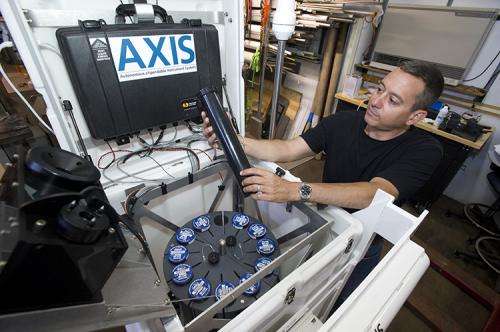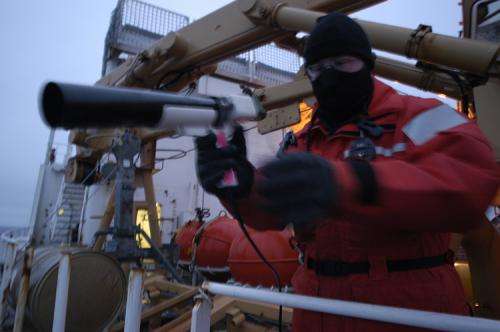Robotic probe launcher may transform ocean data collection

Our understanding of the ocean and its variability relies on the tools ocean scientists deploy to collect data. One tool routinely used is the eXpendable BathyThermograph (XBT) probe, which is usually deployed by hand one at a time at sea.
"We put a ship rider on board and they launch XBT probes approximately every hour for 36 hours until they can't do it anymore," said Jon Hare, oceanography branch chief at NOAA's Northeast Fisheries Science Center (NEFSC) and director of the NEFSC's Narragansett Laboratory in Narragansett, Rhode Island. Oceanographic data has been collected this way for several decades.
"It's been very helpful through the years to have these XBT measurements," said David Fratantoni, associate scientist with Woods Hole Oceanographic Institution (WHOI) and the principal investigator on this project. "But one person per ship going out, standing over the side and shooting one probe at a time is not very efficient. As budgets start to get tighter, that's going to become less sustainable."
To solve this problem, Fratantoni and a team of engineers at WHOI set out to develop an advanced robotic auto-launcher system. Hundreds of XBT probes are manufactured each year and all of them are built to be deployed by hand, so working within the constraints of the probes' existing design was a challenge for the developers. Fratantoni analogizes his challenge to trying to build a new soda machine.
"You can't go ask Coke to change their can," he said.
Over the past five years they came up with the Autonomous eXpendable Instrument System (AXIS), a white box about the size of a mini fridge that contains a carousel loaded with up to a dozen XBT probes. AXIS can be programmed to release a probe at a specific time or location.
"The big step was it's robotic: one launcher, one set of contacts for the probes, and a bunch of machinery that would move new, fresh probes into place. That was really different," Fratantoni said.
The AXIS unit is attached to a rail off the deck of a ship. At a programmed time or location, AXIS will drop a probe out of the bottom of the box into the ocean that sends data back to scientists in the lab via satellite.

"One of the major features of AXIS is it's completely self-contained and self-powered. It has its own communications system, doesn't require any wires, cables, or computers on the ship," Fratantoni said.
The first AXIS prototype was tested at sea over the past 12 months aboard the M/V Oleander, a container ship owned and operated by Bermuda Container Lines and part of the NOAA Ship of Opportunity Program run out of the Northeast Fisheries Science Center's Laboratory in Narragansett, Rhode Island. The M/V Oleander makes weekly journeys between New Jersey and Bermuda, crossing the Gulf Stream on each trip.
Because the Gulf Stream plays a major role in the global redistribution of heat from low to high latitudes and is a crucial component of the earth's climate system, NOAA has deployed oceanographic probes and towed a continuous plankton recorder on the M/V Oleander on a monthly basis since the mid-1970s.
The development and deployment of AXIS has allowed enhanced ocean observations of the Gulf Stream and its variability while substantially reducing the workload at sea.
"This kind of automated system could really open up the opportunity to sample more of the ocean," Hare said.
Chris Melrose, a research oceanographer at the Narragansett Laboratory, heads the NOAA Ship of Opportunity Program at the lab and has been aboard the M/V Oleander testing the AXIS prototype during the past year.
"Commercial vessels are valuable platforms for collecting oceanographic data. As guests on those vessels we must have as little impact on their operations as possible, while still achieving our scientific goals," Melrose said. "A self-contained autonomous system like AXIS helps us to achieve that balance."
The developers envision AXIS units as part of a global observing network using vessels that operate under the auspices of the World Meteorological Organization's Volunteer Observing Ship (VOS) program. AXIS streamlines data collection, facilitates novel and interactive observational approaches, and reduces both the operational cost and logistical complexity of probe deployment from research and commercial vessels.
"It gives us unfettered access to a potential research fleet many, many times larger than the actual academic research fleet. There's no reason why every container ship in the world couldn't have one of these," Fratantoni said of AXIS,
The development of AXIS was made possible by awards from WHOI's Cecil H. and Ida M. Green Technology Innovation Program and the National Science Foundation to Associate Scientist Dave Fratantoni and Principal Engineer Keith von der Heydt. The mechanical and electrical components of AXIS were designed and built by WHOI engineers Terry Hammar and Jeff O'Brien.
With NSF support a second AXIS unit was recently constructed for deployment aboard the M/V Norröna, a Smyril Line ferry operating between Denmark, the Faroe Islands, and Iceland. This route provides an opportunity to regularly monitor the upper limb of the Atlantic overturning circulation, a key component of the climate system. Installation and operation of AXIS aboard Norröna is in support of the NSF-funded Norröna Project led by scientists Tom Rossby at the University of Rhode Island and Charlie Flagg at SUNY-Stony Brook.
"With this installation on the Norröna we hope to significantly improve our ability to determine the transport of heat into the Nordic Seas, a matter of great climate interest," said Tom Rossby, University of Rhode Island emeritus professor of oceanography. "We are very excited about this. This will be, to my knowledge, the first time temperature will be profiled along the Scotland-Faroe-Iceland ridge in such detail, both temporally and spatially. One of the first steps will be to compare these new temperature transects with climatology. We've been waiting a long time to be able to do this."
Provided by Woods Hole Oceanographic Institution

















